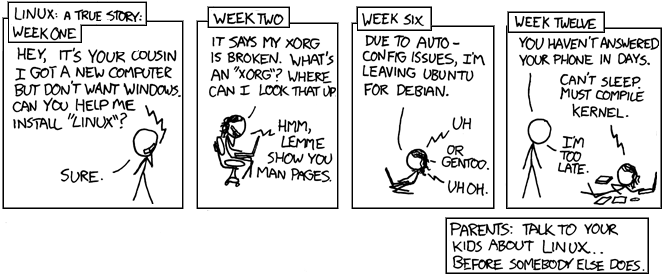Linux Setup
posted by Alex Nahapetyan
There have been a few questions about what environment to use for assembling code/future 1337 things this semester! So in this post, I will try to cover all grounds based on what you have available to you. (Last option is my personal recommendation)

Note: You do NOT need to have this setup! You can install popOS on an old laptop or build Gentoo Linux from the source. You should choose a setup for this semester (especially for the CTF) you are comfortable with, and your computer can support it! (and a setup that can get the job done)
I have a toaster, can’t run anything past chrome?
I would go with VLC! All you need to do is reserve an Ubuntu VM (Ubuntu 18.04 image) and run these commands.
sudo dpkg --add-architecture i386 # Add MultiArch support
sudo apt update # update everything
sudo apt install -y gcc gcc-multilib gdb nasm vim # install gcc and nasm to compile code, gdb because it will come in handy later hint-hint, and vim if you want to edit code using it
I personally would scp your code over to VLC and then scp it back when you are done.
And you can look at this VSCode plugin if you don’t want to use Vim!
Based on past posts, you can see that you won’t be able to use the EOS system, but feel free to use the AFS lockers to back up your work (/afs/unity.ncsu.edu/users/<first letter from UnityID>/<UnityID>).
I have a decent computer with at least 6GB of ram and 4 cores
You have the same option as above, but you can set up your own VM to test things on. Perks include the fact that you can drag and drop things, you can interact with the GUI, and no need to make sure all your stuff is backed up.
You can get Vmware Workstation (Fusion if you are on a mac) from here: https://www.csc.ncsu.edu/vmap/
And then you import this OVA file.
How to import an OVA file VMware
Username: hacker
Password: toor
pwngdb an awesome gdb plugin for reverse engineering (super helpful later on) is installed on this VM but disabled by default. To enable remove the " at the beginning of the ~/.gdbinit.
The Virtual Machine is really slow/laggy; any other options? (Personal recommendation!)
We are going to use Vagrant to configure a Linux server to run-on Virtualbox.
So you will SSH into this VM when you need a Linux shell, and we will share a folder with it, so you can edit your code/modify binaries on your host machine, and you just run them over ssh.
This one will be the easiest to use once you set it up!
- Download and install Virtualbox .
- Install and verify installation for vagrant by following this guide.
- Download this vagrant file
- Put that file in the same folder you want to be shared with your VM.
- Open up a command prompt (terminal or cmd),
cdto that folder, and typevagrant up. - Type
vagrant sshto ssh into the Linux box, and there you go! Now you have a working Linux VM you are SSHed in. The shared folder is in/data
Any time you need a Linux shell, you can just cd to that folder and then type vagrant ssh.
pwngdb an awesome gdb plugin for reverse engineering (super helpful later on) is installed on this VM if you would like to disable it, add a " at the beginning of the ~/.gdbinit.